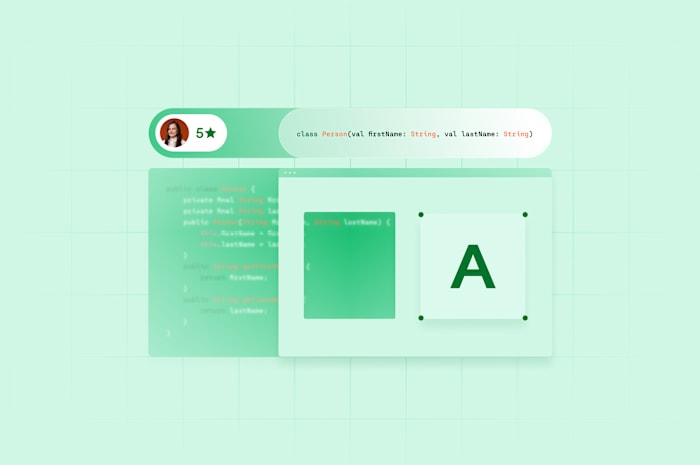Flask vs. Django: Differences, Examples, and Expert Tips
Unlike PHP, Python lacks essential features for creating web applications. Django and Flask provide them. But which should you choose?
 June 17, 2024
June 17, 2024 11 minute reading
11 minute reading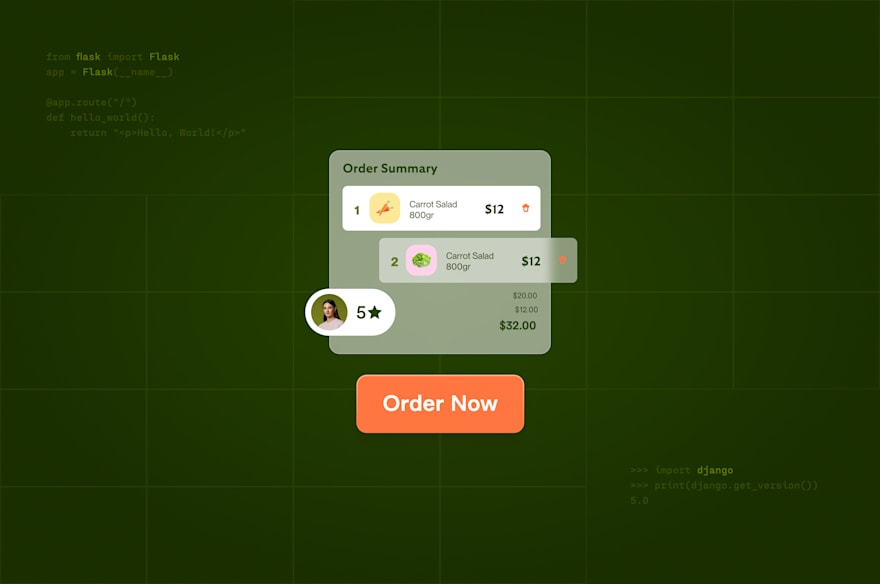
Python is the most used general-purpose programming language in the world. Its standard libraries contain all the essentials for developing sophisticated tools, scripting solutions, and workflow automations.
Python is easy to learn, and many beginners can quickly create and run Python scripts to automate business tasks with the help of online tutorials. Powerful libraries make Python an ideal language for AI and machine learning development.
However, despite its popularity, Python lacks essential elements to create websites easily. Python’s primary purpose isn’t web development, so developers must write web-specific code to make Python work on web servers.
Fortunately, a vibrant Python ecosystem frequently contributes support modules and systems to make Python development easier. Two of the most popular web frameworks for rapid web development are Flask and Django.
Let’s look at these two giants side-by-side.
Hire an expert Python developer on Fiverr
Why do you need a Python web framework?
Python is a general-purpose programming language for software development, desktop application development, data science tools, machine learning solutions, and web applications.
Unlike PHP, Python wasn’t explicitly designed as a web development language, so it lacks the essential built-in features required by all web applications, such as:
HTTP requests
HTTP responses
User sessions and authentication
The subject of HTTP requests alone requires an in-depth understanding of the Hypertext Transfer Protocol. Even a single line break out of place in the protocol can cause errors.
Besides the core essentials, all modern web applications typically require boilerplate code for:
URL routing
HTML template rendering
Form handling and validation
Database connections and ORM (Object-Relational Mapping) support
Writing code yourself to handle each of these points is tedious and can cause grave errors that lead to hacked websites. For example, every database needs basic CRUD (Create, Read, Update, Delete) functions to handle data.
When poorly written, these operations result in severe security flaws called “SQL Injections,” where hackers can inject malicious code into one of the CRUD operations to modify or exfiltrate data.
Using battle-tested, open-source code for core operations means your code will be far more robust, and hackers are less likely to breach your web application.
Django and Flask provide the necessary HTTP and web building blocks to build a web app. These two open-source frameworks contain the essential code for Python developers to create web apps from scratch. Web frameworks are, therefore, crucial for rapid development.
Whether you’re building a web app that returns HTML and JavaScript to the browser, or an API (Application Programming Interface) that gives the outside world access to internal business data, your solution needs features provided by Django and Flask to operate.
What is Flask?
Austrian software developer Armin Ronacher created the first version of Flask by merging two open-source projects: Werkzeug and Jinja2.
Werkzeug (meaning a “tool” in German) is a toolkit that handles many of the backend server requirements in a Python web app. Jinja2 is a front-end template engine that allows for creating dynamic content in web pages using Python-like syntax.
Flask is a microframework that doesn’t require any external libraries for its basic functionality. However, if you want your Flask application to include more advanced functionality, you must import an external library or Flask extension.
For example, if you want to connect Flask to a database, such as PostgreSQL, MySQL, or SQLite, you’ll need to import the Flask-SQLAlchemy extension into your project.
Flask-SQLAlchemy provides an ORM—object-relational mapper—which maps programmatic objects to underlying data structures and is an essential tool for anyone working with databases.
Using ORM, developers first create logical entities in code, which are transferred to the database as data structures by the ORM. The ORM typically generates all the necessary CRUD code for connecting to, reading from, deleting, or updating data in a relational database.
The Flask-Admin extension implements an admin interface to manage your application. Flask-Mail implements an easy way to send emails, and Flask-Login integrates login functionality.
Unfortunately, none of these additional dependencies form part of the basic Flask project. Unique customizations through third-party extensions could lead to bugs, conflicts, and project fragmentation.
What is Django?
Django is a full-stack web framework for Python that includes everything you might need for developing enterprise-grade, scalable web applications. The project follows Python’s “batteries included” motto by having everything necessary to build anything from a simple MVP (Minimum Viable Product) or prototype to massive cloud-based enterprise apps with no external libraries.
For example, starting a new app gives you immediate access to a built-in Django admin interface where you can edit and manage users and create new groups for them. Assigning permissions to user groups is easy, and it’s all automatically generated by Django.
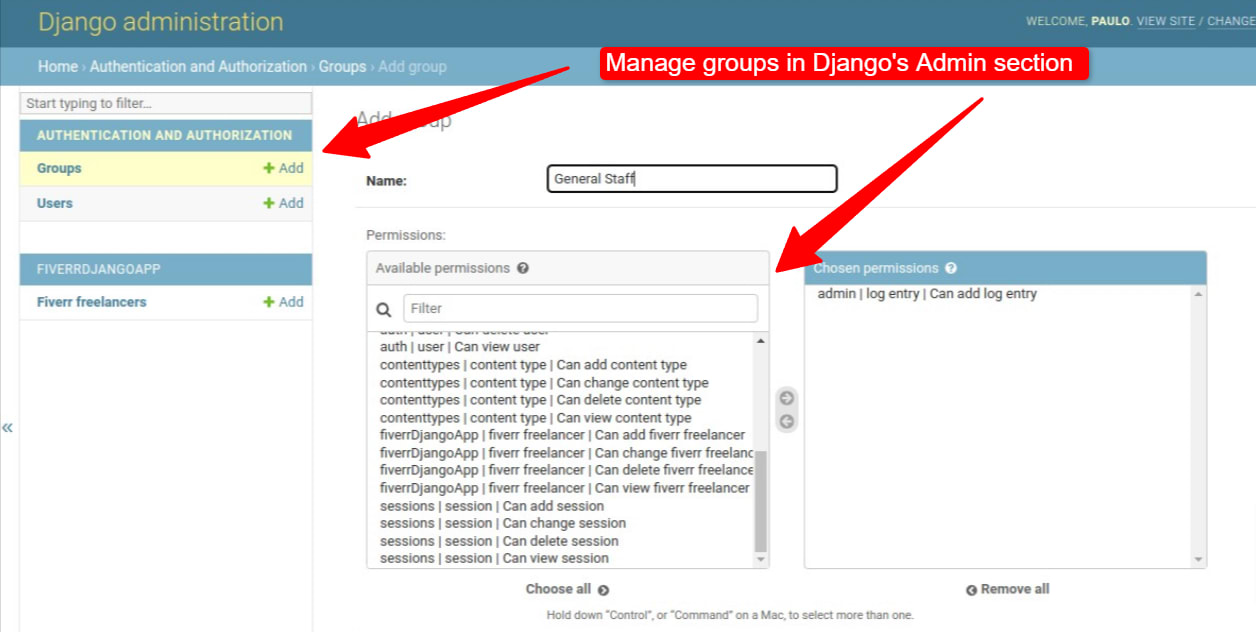
Django admin interface showing how groups are created.
When you define data entities in your code, the built-in Django ORM functionality automatically adds a section in Django admin for you to manage those records.
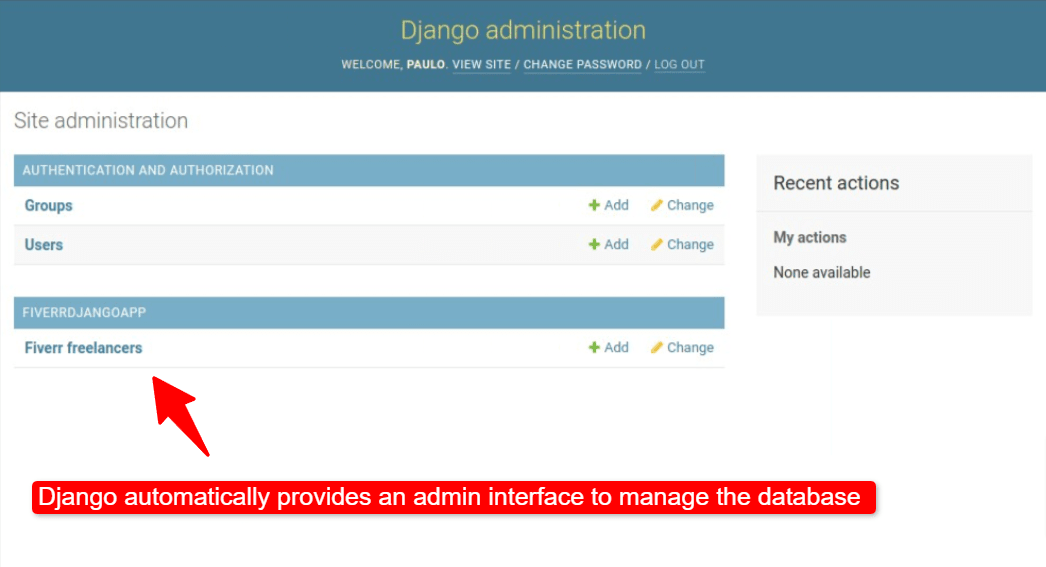
Django admin automatically displays database entities and lets you manage them.
Unfortunately, Django’s “batteries included” philosophy comes at a cost—a steep learning curve and frustration for beginners when creating a new project. Creating a new Django project requires several steps, none intuitive, including editing multiple files and starting the development server from the command prompt.
In Flask, however, starting a new Flask project is as simple as installing Python Flask using the pip command and then writing the following few lines of code:

Lines of code required for starting a Flask app.
The pip command for installing Flask is:
pip install flask
Django vs. Flask: Popularity
According to Google Trends, interest in Django has remained steadily higher than Flask for the last 12 months. However, interest in Django started waning in July 2023, while interest in Flask showed a slow rise.

Google Trends comparing Django and Flask for the last 12 months.
The United States, Australia, and Southern Africa are more interested in Django than Flask.
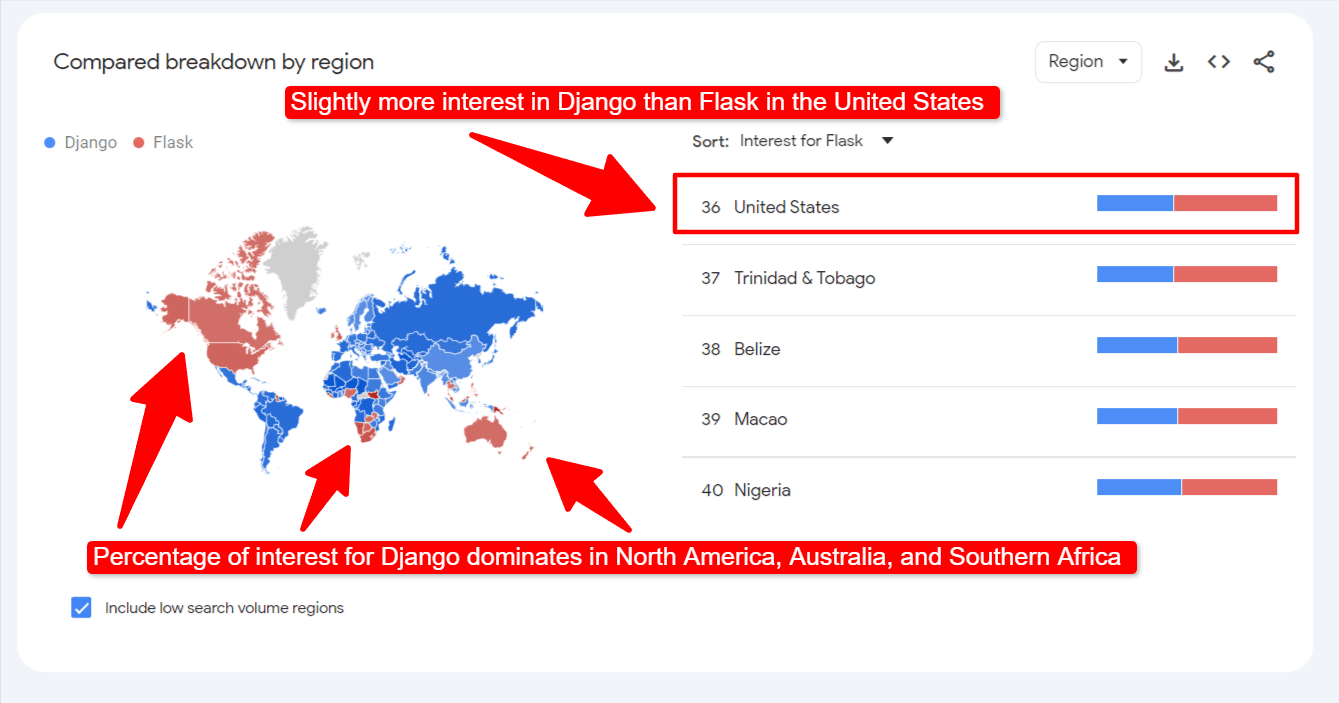
Google Trends map showing the percentage of interest for Django and Flask.
Both projects are extremely popular on GitHub. Flask’s GitHub project page has 65,400 stars, while Django developers gave Django’s GitHub page 75,000 stars.

Flask stars and forks on GitHub.

Django stars and forks on GitHub.
Stack Overflow’s 2023 Developer Survey shows slightly more developers, including professional developers, use Flask instead of Django regularly. However, more developers learning to code use Django instead of Flask.
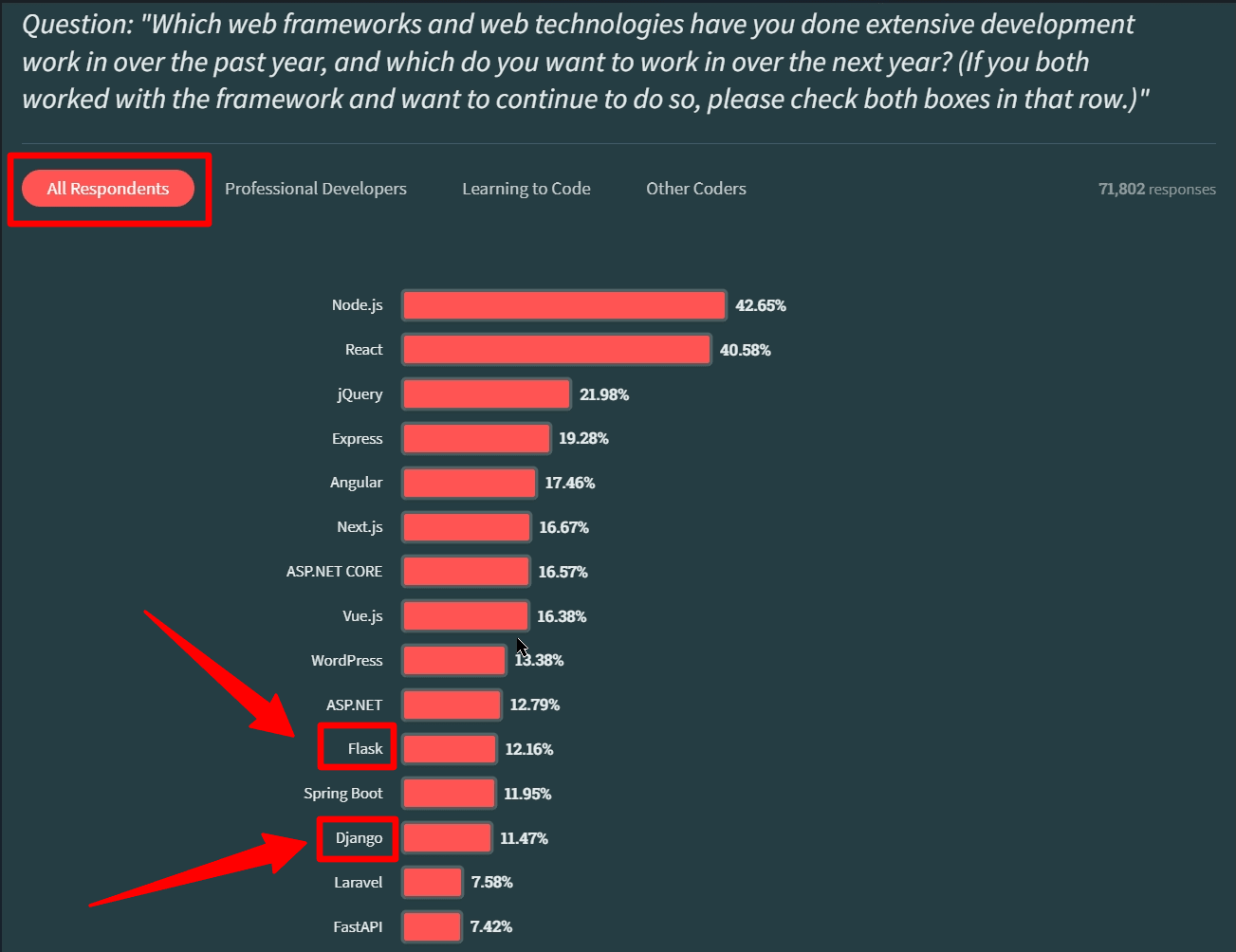
Stack Overflow Developer Survey results for web frameworks (all developers). Image courtesy of Stack Overflow.
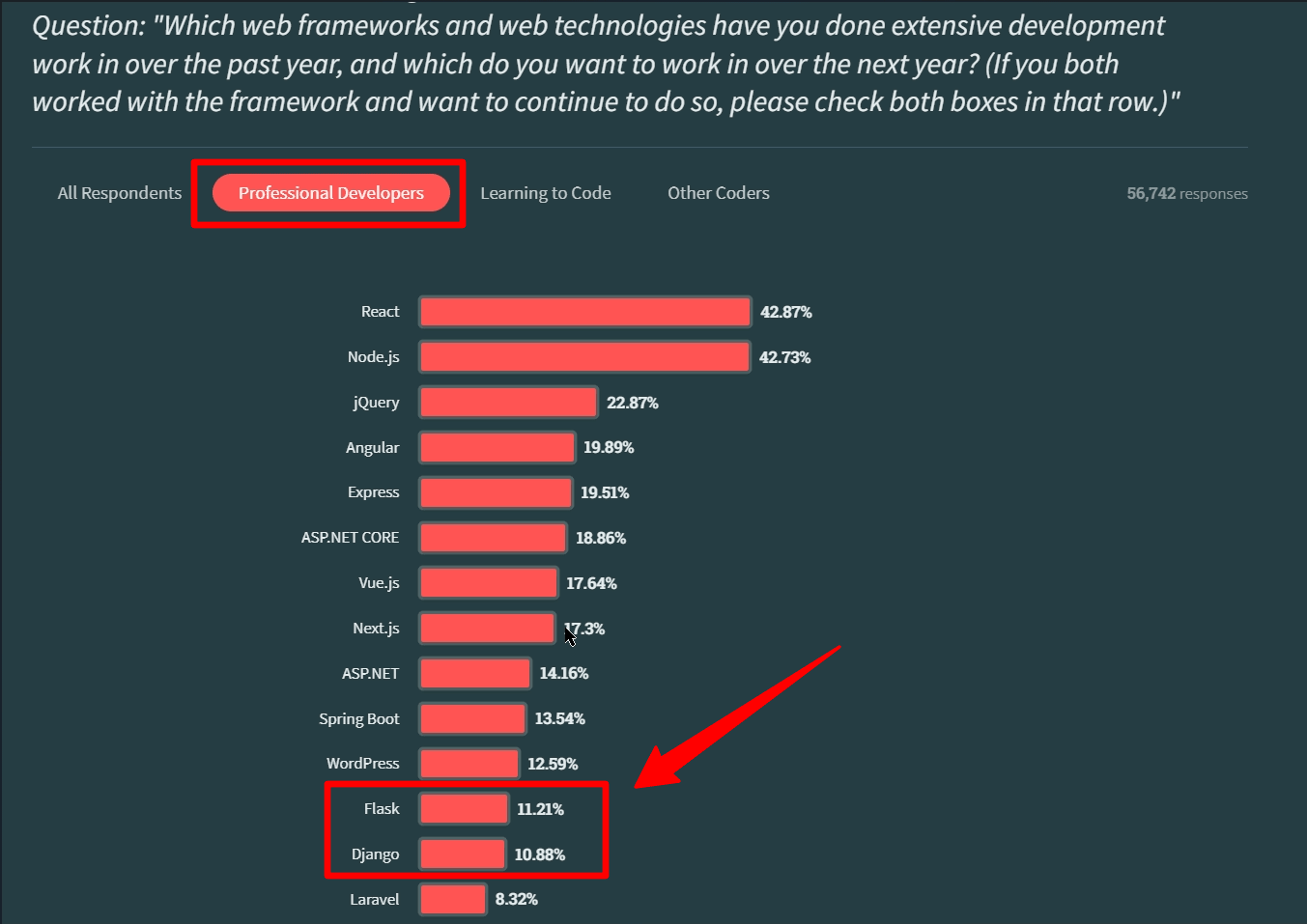
Stack Overflow Developer Survey results for web frameworks (professional developers). Image courtesy of Stack Overflow.
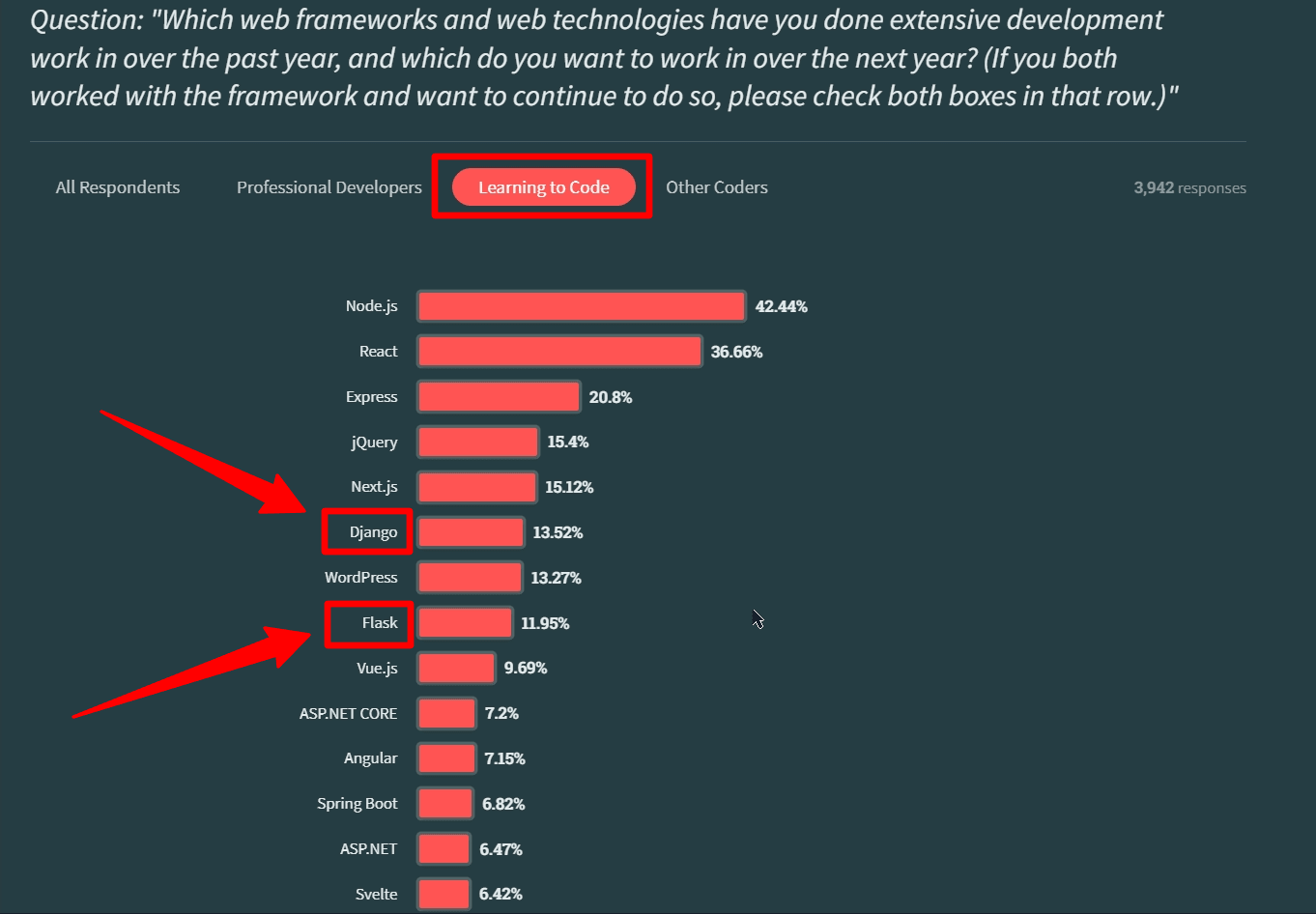
Stack Overflow Developer Survey results for web frameworks (developers learning to code). Image courtesy of Stack Overflow.
If you’d like to learn to program in Django, Flask, or Python, buy online coding lessons from Fiverr experts to get started.
Do corporations prefer Django or Flask?
Finding definitive and accurate lists of which corporations use which technologies is challenging. Many of the lists that exist don’t cite sources.
Occasionally, a company writes a blog post specifying the tech they use. For example, we know Netflix wrote a blog post in 2019 about using Flask and Python. However, analyzing the Netflix website with Wappalyzer doesn’t reveal Flask being used.
One list suggests that Airbnb uses Flask. When we checked it with Wappalyzer, we saw that the Airbnb website was built using Ruby on Rails.
If you’re trying to decide which framework to learn to land a job, hunting job sites to see how many offers are available for each framework is easier than identifying the technologies Fortune 500 companies use.
Django vs. Flask: What’s the difference?
Django imposes more rules than Flask and sacrifices flexibility for scalability. However, the imposition of these standards is similar to why Angular is more opinionated than Vue—because rigorously sticking to standards and styles is essential for massive projects.
Django’s opinionated nature means that large teams can work on a project with less risk of project confusion than with Flask.
Django’s suitability for enterprise-level projects comes at a cost. The language has a steeper learning curve than Flask, and programmers must grasp numerous complex concepts before programming in Django.
Simple tasks, such as adding a new route (web page) to a Django project require changing multiple code lines in different files. Although excellent for maintaining Django’s Model-View-Controller (MVC) architecture, the process can feel frustrating for developers working on small projects.
On the other hand, you can set up Flask’s code and architecture intuitively, allowing developers to dive right in.
When considering small projects with tiny budgets, Django’s additional steps per change might inch the budget up. Conversely, the budgets for enterprise-grade projects might spiral out of control when using Flask.
None of these points are set in stone. If you’re already an expert in Django, development time will likely be faster if you stick with what you know. Alternatively, if you’ve inherited a large, well-documented, well-tested Flask project that needs new features, changing the entire codebase to Django might be risky. Rewriting an entire codebase that already works is rarely a good idea.
If you have a Django or Flask project and lack the resources to handle it, you can always buy Python programming services from Fiverr.
Comparing Django and Flask
Covering every difference between Django and Flask in a single article would be impossible—you’d need a full-scale tutorial for that.
However, some differences and similarities are significant, so let’s look at them:
Architecture
Django is often described as a monolithic framework, meaning the app you’re building begins and ends inside that single Django project. Flask is often described as following a more modern microservices architecture, where each module operates independently, using an API-first approach.
Describing Django as monolithic is a bit of a misnomer. “Monolithic” typically refers to large, on-site, siloed apps. If one part of these apps crashed, the entire system went down. That isn’t Django’s philosophy, and it’s possible to use Django to create a distributed microservice-based application.
Instead of describing Django as monolithic, the difference in architecture for both frameworks is best described by the “batteries included” concept: You can and must use many different batteries to power Flask.
Debugging
Flask’s built-in development server includes a simple debugger that provides detailed debugging information in the browser when an error occurs. To activate it, you must set the debug parameter to True when running the server, as shown in the code below:

Flask code sample showing how to enable the debugger.
When we run the code, the browser shows the following detailed traceback to help you find the source of the bug:
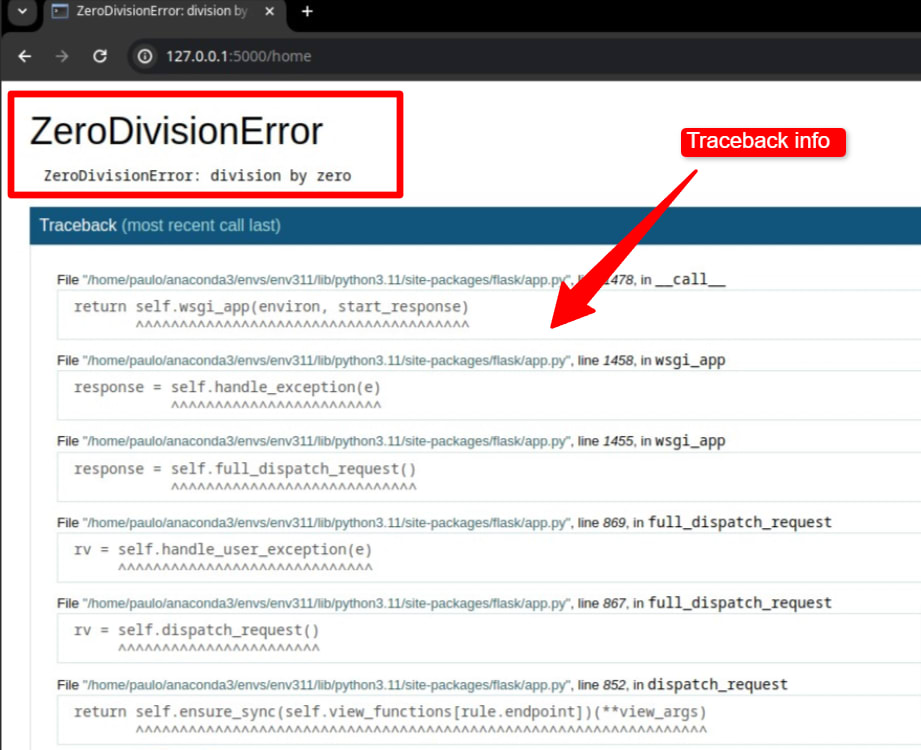
Flask’s debugger displays error information in the browser.
Important: The built-in debugger isn’t triggered when you write unit tests using Python’s unittest module. Unittest assertions get printed to the console as usual.
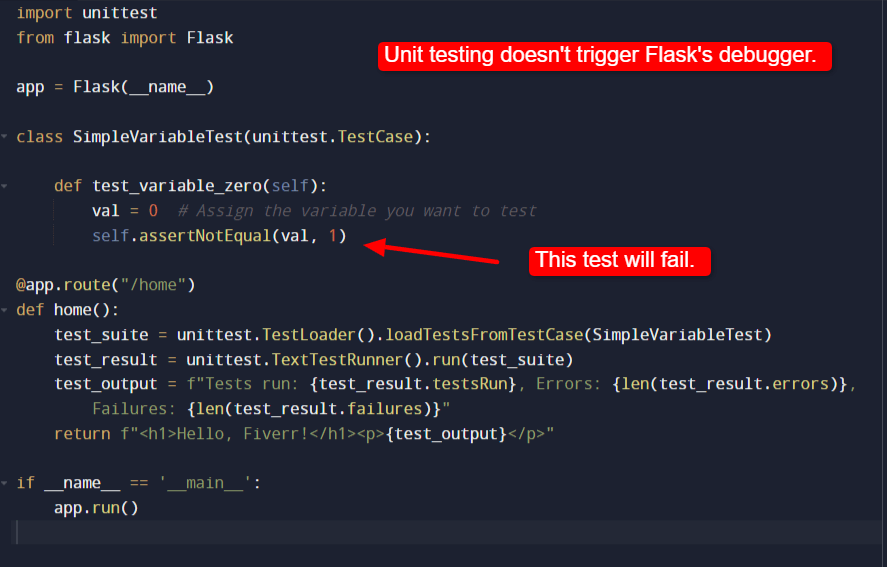
This failed unit test doesn’t trigger the debugger.

Unit test results are printed to the debug console.

You can output the result of unit tests to the browser by explicitly coding an HTML output.
That’s mostly where Flask debugging begins and ends, which is sufficient for many use cases.
Django offers a more comprehensive built-in framework for debugging and unit testing. Django’s debugger is closely integrated with its ORM and templating system, providing a more detailed level of insight, especially for complex applications.
Django also includes a comprehensive logging feature that allows developers to log additional information to understand how the app performs.
After finishing your app, you can buy user testing services from Fiverr experts to find and handle those last few bugs that only get discovered once the software is used.
Templating
Django has its own Django-specific templating system, whereas Flask uses the popular Jinja2 templating engine. Both systems have similar syntax. However, Django’s system can only be used inside Django, whereas Jinja2 works independently. You can even use Jinja2 templates inside a Django app.
Although any templating system lets you integrate the front-end design with programming code, creating a beautiful design requires its own set of skills. If you need help designing an attractive front-end for your Python web app, you can buy website design services from Fiverr experts.
Routing
Flask’s approach to routing is far more intuitive and much more straightforward than Django’s. Setting a route in Flask is as easy as decorating a function with the @app.route decorator, followed by the route path.
For example, the following two functions and their respective decorators define two routes. One route also includes a variable—“username”—that we can access in the code:

Defining two routes in Flask in the same file.

Flask and Django let you define dynamic routes.
Django has a far more complex routing system. To define a route in Django requires you to edit three separate files.
Django also supports dynamic URLs.
Databases
Django’s built-in ORM supports several relational databases out of the box:
PostgreSQL
MariaDB
MySQL
Oracle
SQLite
To enable database support in Flask, you must install a third-party tool, such as Flask-SQLAlchemy.
Authentication
Django provides a robust, built-in framework for user authentication and authorization. Its built-in admin interface also lets you manage users directly.
You must use the Flask-Login and Flask-Security logins to enable authentication on a Flask site. These plugins aren’t part of the core Flask project, meaning their release cycles might differ from the main project, potentially leading to incompatibilities.
Using Flask and Django for AI chatbots
Both frameworks work well for creating an AI chatbot. An API typically powers AI chatbots, so the framework it’s built in is less important than your chosen API. At the moment, ChatGPT’s API is one of the most popular. Using Flask or Django, you can rapidly build the surrounding infrastructure for the chatbot.
However, front-end frameworks, such as Angular and Vue, are also excellent candidates for creating an AI chatbot.
Regardless of the surrounding technology you use, you must ensure the chatbot operates smoothly and provides an excellent user experience (UX). Once you’ve built the chatbot, consider buying UX design services from Fiverr freelancers to ensure users enjoy using it.
Buy Python programming services from Fiverr
Fiverr is an online marketplace offering services from professional freelancers in all the major digital business categories. Fiverr has many Django, Flask, and other Python developers who can build your web app in Python or upgrade an existing Python app.
To find a freelancer, search for the service you need using the skills box at the top of the Fiverr home page. You can also filter by service category to browse seller profiles.
Once you find a developer, contact them to strike up a conversation. When you’re ready to order, the developer can send you an offer, or you can purchase a service directly from their gig page.
To get started, open a Fiverr account today.
